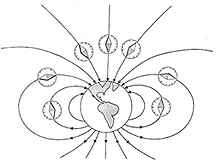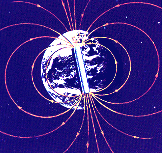|
When researchers map the three-dimensional flow of a river around a bridge pier, or of wind aroundthe wing of an airplane (picture below), they use streamlines, lines that trace the flow of particles of water or air.
| 
|
|
When researchers map the three-dimensional flow of a river around a bridge pier, or of wind aroundthe wing of an airplane (picture below), they use streamlines, lines that trace the flow of particles of water or air.
| 
|
|
Field lines converge where the magnetic force is strong, and spread out where it is weak. For instance, in a compact bar magnet or "dipole," field lines spread out from one pole and converge towards the other, and of course, the magnetic force is strongest near the poles where they come together. The behavior of field lines in the Earth's magnetic field is very similar.
| 
|

| Field lines were introduced by Michael Faraday (see history), who named them "lines of force." For many years they were viewed as merely a way to visualize magnetic fields, and electrical engineers usually preferred other ways, mathematically more convenient. Not so in space, however, where magnetic field lines are fundamental to the way free electrons and ions move. These electrically charged particles tend to become attached to the field lines on which they reside, spiralling around them while sliding along them, like beads on a wire (drawing below).
|
|
Because of this attachment, the behavior of electrified gas ("plasma") in space, a gas of free ions and electrons, is dictated by the structure of field lines: electric currents, for instance, find it easiest to flow along such lines. Indeed, the role of field lines in a plasma resembles that of grain in wood: just as the grain is the "easy" direction along which wood splits most readily, so the direction of field lines is the one along which particles, electric currents, heat and certain types of waves prefer to flow.
| 
|
"Exploration" home page (index) Glossary
Next Stop: #5H. Field Lines--History
 Official GSFC Home Page .........
Official GSFC Home Page .........
 NASA WWW Home Page
NASA WWW Home Page
Last updated March 13, 1999